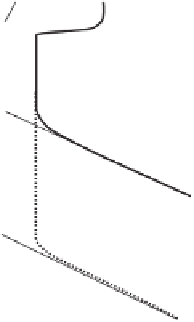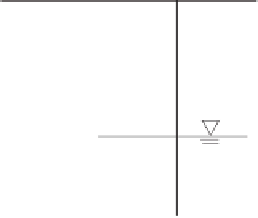Environmental Engineering Reference
In-Depth Information
Pore-water pressure, kPa
+
u
w
−
u
w
−
10
−
5
0
5
10
3.0
Ground surface
Clay
Time
increases
q
<
k
sat
Steady state bound
2.0
Sand
1.0
Case I
∇
0.0
Sand
+
u
w
−
u
w
-1.0
Case II
-2.0
∇
q
<
k
sat
Time increases
-3.0
Figure 8.74
Variation of pore-water pressure with depth in the
clay liner and the underlying sand layer for a surface water flux,
q
=
k
s
,clay
=
0
.
0068
k
s
,sand
. (modified from Kisch, 1959).
Figure 8.76
Infiltration into unsaturated soil under transient seep-
age conditions with two different ground surface moisture fluxes.
(equal to
k
s,
clay
), is equal to the coefficient of permeability of
the unsaturated sand. Figure 8.75 shows typical pore-water
pressure distributions under steady-state conditions. Hydro-
static conditions correspond to the situation where there is
no moisture flux at the ground surface. Under steady-state
infiltration conditions the gradient of pore-water pressure is
−
coefficient of permeability of the soil, and the water storage
of the soil. The matric suction in the unsaturated soil can
decrease but will not disappear when the flux is less than the
saturated coefficient of permeability. Only when the ground
surface moisture flux is equal to or greater than the satu-
rated coefficient of permeability can the matric suctions be
eliminated with depth. The conceptual framework set forth
by Kisch (1959) sets steady-state bounds for the infiltration
of water into unsaturated soils.
1, as shown in Fig. 8.75. The water flux in and out of the
soil becomes equal. If the water flux is the same as the coef-
ficient of permeability of the unsaturated soil at a particular
value of matric suction, the pore-water pressure gradient is
zero as shown in Fig. 8.75.
Figure 8.76 shows typical pore-water pressure distribu-
tions under transient conditions. Infiltration under transient
conditions can be considered as a transitional state between
the initial and final steady states. The time to reach steady-
state conditions is a function of the ground surface flux, the
8.4.2 Numerical Modeling of Steady-State Conditions
Let us consider a slope of 20 m in height inclined at 30
◦
.
The slope is assumed to consist of a homogenous, isotropic
soil. A series of finite element saturated-unsaturated seep-
age analyses were conducted in order to study the influence
of various unsaturated soil properties on the infiltration of
water into the slope. The geometry and boundary condi-
tions are shown in Fig. 8.77 (Zhang et al., 2004). Constant
hydraulic heads were applied along the left and right bound-
aries below the groundwater table. A zero flux boundary
was applied along the left and right boundaries above the
groundwater table. The groundwater table was fixed as a
straight line between the boundaries in order to consider the
same cross section for each set of soil and boundary condi-
tions. The lowermost material in the slope was assumed to
be impermeable.
Precipitation was modeled as a moisture flux boundary
q
applied along the ground surface. Section
X-X
located
in the middle of the slope was used to illustrate the pore-
water pressure profile in response to applied precipitation.
Increasing
q/k
s
at
ratio
−
u
w
+
u
w
Hydrostatic
condition
Figure 8.75
Infiltration into an unsaturated soil under steady state
conditions with various ground surface moisture fluxes expressed
as a ratio of the saturated coefficient of permeability at ground
surface.




















Search WWH ::

Custom Search